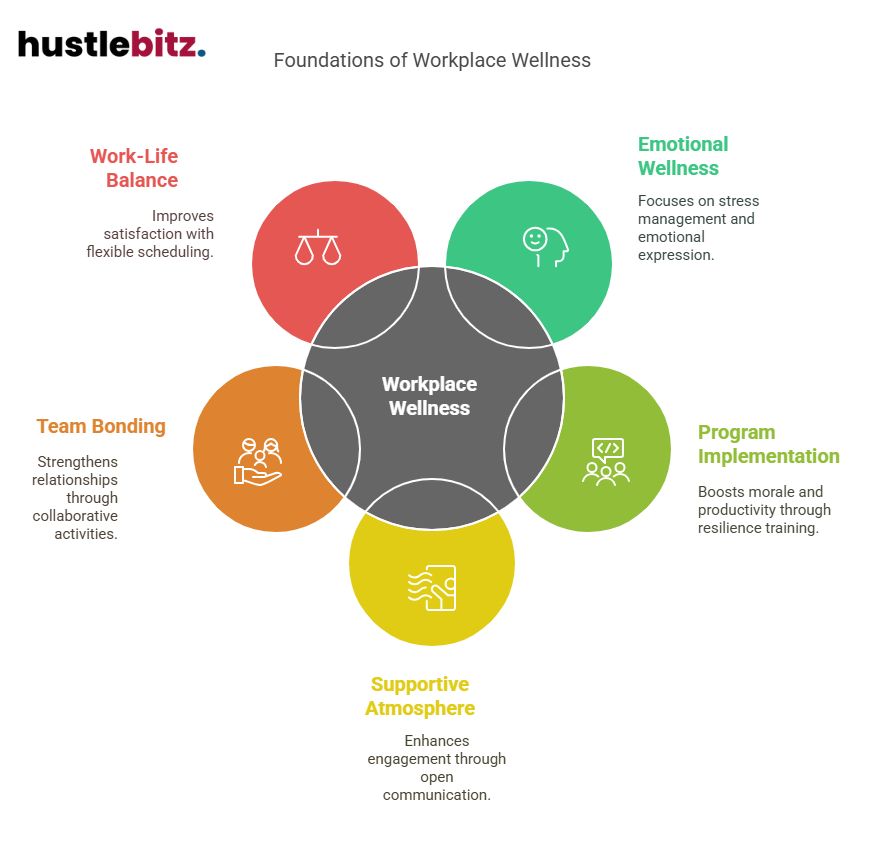Prioritizing emotional wellness in the workplace is vital for enhancing employee morale and productivity. It involves promoting stress management, fostering fulfilling relationships, and encouraging work-life balance. Organizations should offer resources like wellness programs and mental health support to help employees cope with challenges. Creating a supportive atmosphere through open communication and recognition programs reinforces a culture of appreciation. Leadership plays a crucial role in modeling practices that value emotional wellness. By addressing burnout and providing tools for resilience, workplaces can transform their culture, ultimately leading to better performance outcomes. Learn how various strategies can further enhance emotional wellness initiatives.
Key Takeaways
- Emotional wellness includes stress management, constructive emotional expression, and fulfilling relationships, all essential for a positive workplace environment.
- Implementing emotional wellness programs boosts employee morale, productivity, and reduces absenteeism through resilience training and mindfulness practices.
- Creating a supportive atmosphere through open communication and accessible resources enhances employee engagement and contributes to a positive workplace culture.
- Team bonding activities foster social connections and collaboration, strengthening relationships and increasing overall morale and productivity.
- Promoting work-life balance through flexible scheduling and mental health support improves job satisfaction and retention rates among employees.

Understanding Emotional Wellness

Emotional wellness, a crucial aspect of overall health, encompasses the ability to manage stress, express emotions constructively, and maintain fulfilling relationships in the workplace. At the foundation of emotional wellness is emotional intelligence, which enables individuals to recognize their own emotions and those of others. This awareness fosters a positive workplace culture where collaboration thrives, and employees feel valued.
Effective stress management is essential for emotional wellness. Incorporating self-care practices such as regular physical activity, adequate sleep, and healthy eating can significantly enhance an individual’s ability to cope with challenges. Additionally, organizations can promote resilience building through targeted empathy training, which equips employees with the skills to understand and support their colleagues during difficult times.
Mindfulness techniques, including meditation and deep-breathing exercises, are also valuable tools in nurturing emotional wellness. These practices encourage individuals to stay present, reducing anxiety and improving focus. Furthermore, achieving a healthy work-life balance is vital; when employees feel they have time for personal interests and family commitments, their emotional well-being improves.
Social support plays a critical role in emotional wellness, as strong interpersonal relationships provide a buffer against stress. Employers should foster mental health awareness by creating open dialogues around emotional health and promoting resources available for support. By prioritizing emotional wellness, organizations not only enhance employee satisfaction but also contribute to improved productivity and a healthier work environment.
The Impact of Workplace Stress

How does workplace stress affect employee performance and overall organizational health?
Workplace stress can significantly undermine both employee well-being and the effectiveness of an organization. High levels of workplace anxiety can lead to decreased productivity, as employees struggle to focus and maintain their motivation.
Furthermore, the absence of effective stress management practices can erode employee resilience, making it challenging for individuals to cope with daily pressures. A lack of coping strategies can exacerbate feelings of burnout, directly impacting mental health and leading to high turnover rates.
This not only disrupts team dynamics but also creates a detrimental workplace culture where psychological safety is compromised. Employees may hesitate to express concerns or seek support, resulting in an environment that stifles innovation and collaboration.
Organizations that prioritize burnout prevention and foster a culture of open dialogue create a more supportive atmosphere. Encouraging work-life balance is essential, as it allows employees to recharge and maintain their mental health.
When employees feel valued and supported, their performance improves, leading to enhanced organizational health.
Recognizing Signs of Burnout
Identifying the signs of burnout is crucial for maintaining employee well-being and fostering a healthy organizational environment. Burnout symptoms often manifest as chronic fatigue, irritability, and a sense of detachment from work. Employees experiencing these feelings may struggle with motivation, leading to productivity loss and diminished team dynamics. Recognizing these symptoms early is essential to implement effective coping mechanisms.
Effective stress management techniques, such as mindfulness practices and time management strategies, can help alleviate the effects of burnout. Encouraging a healthy work-life balance is vital; employees should feel empowered to set boundaries that promote self-care strategies. Employers can support this by promoting flexible work arrangements and encouraging regular breaks to recharge.
Emotional intelligence plays a critical role in recognizing burnout not only in oneself but also in colleagues. By fostering an environment where individuals feel safe to express their struggles, organizations can enhance mental resilience and support recovery techniques. This proactive approach can create a culture that values emotional wellness, ultimately benefiting both employees and the organization.
Benefits of Emotional Wellness Programs

Implementing emotional wellness programs can significantly enhance employee morale and productivity, serving as a proactive measure to address burnout and promote overall mental health in the workplace. These programs contribute to a positive workplace culture by fostering employee engagement and cultivating a sense of belonging among team members.
One of the key benefits of emotional wellness initiatives is their role in effective stress management. By equipping employees with tools such as resilience training and mindfulness practices, organizations can empower staff to navigate challenges with greater ease. This not only enhances emotional intelligence among employees but also leads to improved interpersonal relationships, creating a supportive team environment.
Moreover, investing in emotional wellness programs provides a substantial productivity boost. When employees feel supported in their mental health journeys, they are more likely to remain focused and committed to their tasks. This increased concentration translates into higher output and better quality work, benefitting the organization as a whole.
Additionally, these wellness initiatives can significantly reduce absenteeism and turnover rates. Employees who receive adequate support for their emotional well-being are less likely to experience burnout, ultimately leading to a more stable workforce.
Strategies for Supporting Employees

Creating a supportive workplace environment involves a multifaceted approach that prioritizes open communication, accessible resources, and tailored wellness programs for employees. A key strategy is to enhance employee engagement through regular feedback mechanisms and transparent dialogue. This fosters a culture where employees feel valued and heard, ultimately contributing to their emotional wellness.
Implementing wellness initiatives, such as stress management workshops and mindfulness training, can significantly benefit employees by equipping them with tools to navigate daily challenges. These programs should be complemented by supportive policies that encourage work-life balance, enabling employees to manage their professional and personal responsibilities effectively.
Offering mental health days as part of a comprehensive benefits package allows employees the opportunity to recharge when needed, reinforcing the importance of emotional health in the workplace. Additionally, flexible scheduling options can accommodate employees’ varying needs, promoting resilience building and reducing burnout.
Team bonding activities can further strengthen workplace relationships, enhancing collaboration and mutual support among colleagues. This sense of community is vital for fostering a positive environment where employees can thrive.
Lastly, organizations should actively promote and communicate the available resources to ensure employees know how to access support when necessary. By prioritizing these strategies, companies can create a culture that not only values emotional wellness but also drives overall productivity and job satisfaction.
Creating a Positive Work Environment

A positive work environment is characterized by mutual respect, collaboration, and a strong sense of community among employees, all of which contribute to enhanced morale and productivity. To cultivate such an environment, organizations can implement team building initiatives that foster relationships and encourage cooperation. These activities not only strengthen social connections but also enhance employee engagement, allowing individuals to feel more invested in their roles.
Workplace flexibility plays a pivotal role in promoting work-life balance, enabling employees to manage their professional and personal commitments effectively. Alongside this flexibility, incorporating recognition programs can serve as a powerful tool for positive reinforcement, acknowledging employees’ contributions and achievements. This recognition fosters a culture of appreciation and motivates individuals to excel.
Effective stress management strategies are also essential in creating a supportive atmosphere. Providing resources such as wellness programs or mental health days ensures employees have the tools to cope with challenges. Moreover, a focus on conflict resolution can help maintain harmony within teams, allowing any disputes to be addressed constructively and swiftly.
Cultural inclusivity further enhances a positive work environment, ensuring that diverse perspectives are valued and embraced. By fostering an environment where every employee feels respected and included, organizations can enhance morale and productivity.
Encouraging Open Communication
Fostering an environment of open communication is essential for nurturing emotional wellness in the workplace, as it encourages transparency, trust, and collaboration among employees. Establishing a culture that promotes open dialogue enables individuals to express their thoughts and feelings without fear of judgment, thereby creating safe spaces for discussion. This sense of security is vital for addressing mental health issues and facilitating team bonding.
Active listening is a cornerstone of this communication strategy, allowing employees to feel heard and valued. By implementing communication tools that enhance interaction, organizations can cultivate a feedback culture where constructive criticism is welcomed, and peer support is encouraged. This not only strengthens relationships but also enhances team dynamics.
Moreover, vulnerability acceptance plays a crucial role in encouraging employees to share their experiences and challenges. When leaders demonstrate empathy and engage in empathy training, they model behavior that fosters emotional safety, making it easier for others to open up.
Incorporating regular check-ins and team meetings can further enhance communication, providing opportunities for employees to voice their concerns and share successes. By prioritizing these practices, organizations can create a supportive environment that values emotional wellness, ultimately leading to improved job satisfaction and productivity.
Resources for Mental Health Support

Building on the foundation of open communication, providing accessible resources for mental health support is vital for empowering employees to seek help and maintain their emotional wellness in the workplace. Organizations should prioritize the availability of comprehensive mental health resources, ensuring employees can easily access the support they need.
Employee assistance programs (EAPs) are invaluable, offering confidential counseling services that help individuals navigate personal and work-related challenges. These services can address various issues, from stress management to crisis intervention, providing immediate support when needed.
Additionally, organizations can enhance their offerings by promoting wellness apps that facilitate self-care, mindfulness programs, and resilience training, enabling employees to develop coping strategies and increase their emotional fortitude.
Support groups, whether in-person or virtual, can foster community and understanding among employees facing similar challenges. Online therapy platforms have also gained traction, offering convenient access to licensed professionals, which can be especially beneficial for those who may feel hesitant to seek help in person.
Final Thoughts
Prioritizing emotional wellness in the workplace is essential for creating a healthy, supportive, and productive environment. By fostering open communication, providing mental health resources, and implementing wellness programs, organizations can enhance employee well-being and build a resilient workforce. Leaders play a crucial role in modeling these values and ensuring that emotional wellness remains a priority. Ultimately, a culture that values emotional health leads to higher employee satisfaction, better performance, and a positive workplace atmosphere where everyone can thrive.




